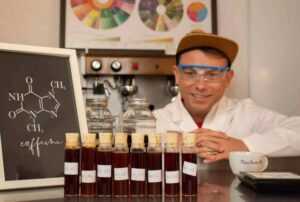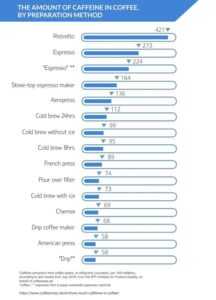MILAN – Started way back in 2008, Coffeeness.de began as a passion project for Arne Preuss who used to be a barista at Starbucks. It has since become the largest coffee blog in Germany, with close to 400k monthly visitors. It’s available in English, Spanish, French and Dutch so that Arne can share his love for coffee with people all around the world.
We read about the interesting research he conducted this year with focus on the caffeine content in the drink we usually drink daily, investigating how it can vary depending on different parameters.
With Arne Preuss, we wanted to delve directly into his method of analysis, the premises that led him to gather certain results
“To be honest, one of my main goals in completing a caffeine study was to put an end to all the speculation. As someone who spends a lot of time testing equipment, writing about coffee makers and, well, drinking coffee, I felt like I should have a better understanding of the caffeine content side of things.
Anyway, I was getting tired of people making baseless claims about coffee actually being
“stronger” than espresso. Plus, was I really getting more jacked after downing a tall glass of cold brew, or was it all in my mind?
At the end of the day, there didn’t seem to be any definitive answers that were easy enough for a non-scientist to understand. So I took it upon myself to change that!
Challenges and Concessions
As much as I wanted to embark on a scientific study of the caffeine content in coffee, I quickly realized that I wouldn’t be able to conduct “the one study to rule them all.”
After all, coffee grown in Latin America is going to be different from an Indonesian crop in many different ways, not least in its caffeine content. And that’s before we even get to the question of Arabica vs Robusta. To top it all off, the degree to which any coffee is roasted plays a huge part in how much caffeine will be released during brewing.
I also had to take the “human factor” into consideration. Although we tried to be as exact as possible throughout, there’s no getting around the fact that small inconsistencies in preparation were likely. Sure, we relied on the skills of an expert barista for the espresso samples. However, Daniel from Flying Roasters in Berlin isn’t a robot!
Ultimately, I settled on the idea of a caffeine test “by the people, for the people.” Of course, weìd try our hardest to be as precise as possible. And we’d use a real lab for testing. But what was really important was to produce information on the caffeine content of various brew methods that anyone could read and understand.”
How we conducted the test

Arne Preuss continues: “After much deliberation, I settled on a 100 percent Arabica from Honduras for the caffeine test. Thanks to its omni-roast profile, this certified-organic single origin coffee would be ideal for all preparation methods. It tastes great too, which would be pretty darn important, seeing as we intended to taste each sample we prepared.
I wanted to provide information about the caffeine content in 15 different preparation methods, ranging from espresso to French press. We prepared each type of coffee according to precise and verifiable parameters, taking notes as needed.
We collected 50-milliliter samples from each preparation method, then delivered them in-person to the Institute for Product Quality (IFP) in Berlin. These guys specialize in food analysis, so we knew our precious cargo was in good hands.
Arne Preuss, results and observations
Upon receiving the results of my caffeine test, the thing that stood out immediately was that a ristretto espresso is both the most highly caffeinated version of coffee and (almost) the least. It turns out all those folks who imagined a straight espresso being the ultimate pick-me-up were right. Sort of.
When comparing preparation methods, a ristretto has the most caffeine per 100 milliliters by a long shot. Pun very much intended. However, given its limited serving size, a ristretto won’t give you nearly the same buzz as a glass of cold brew.

As I’d expected, the longer the contact time between ground coffee and water, the higher the caffeine content. At least in non-espresso type methods. It would seem that during espresso extraction, even though there’s minimal contact time, the fineness of the grind (and, hence, increased surface area) plays a huge part in helping release caffeine.
All in all, the test confirmed that serving size is everything in terms of caffeine content. With that said, we weren’t able to determine the effects of quickly knocking back an espresso vs slowly sipping a cup of French press over the course of an hour. Who knows, maybe that’ll be my next scientific venture.
The Takeaway
Overall, I’d say my caffeine study was a resounding success. We’ve received loads of great
feedback, as well as the inevitable string of comments by folks intent on ripping our
methodology to shreds. I’m well aware of how easy it is to call all sorts of aspects of my study into question.
However, I was well aware of the fact that there’d be inconsistencies and plain old human error involved. Plus, there’s that inconvenient fact that every coffee bean is different. Still, I’m happy that there’s finally a reference available for everyone to use. If it helps educate people so they can moderate their daily caffeine intake, I’d call it a win.”
You can see the full study over at Coffeeness.de/en.
A little about the author: Arne Preuss is the founder and ceo of Coffeeness
Launched in 2008, Coffeeness has become one of the biggest coffee blogs, and is now a popular online destination for all things coffee-related.
When Arne isn’t testing out super automatic espresso machines, putting grinders through their paces or sampling a new crop of specialty coffee beans, you’ll find him relaxing with a tall glass of cold brew.


















